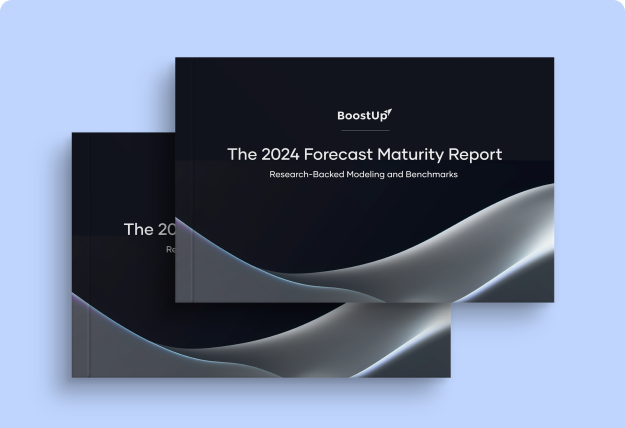The Revenue Blog /
How to Ensure Data is Accurate? Tips from a RevOps Perspective
How to Ensure Data is Accurate? Tips from a RevOps Perspective

Topics covered in this article
How the experts ensure their data is as accurate as possible
When it comes to making decisions for your business, how can you ensure that your forecast, sales analytics, and revenue intelligence are giving you the data you need to make the best possible decision?
Jeremy Donovan of Insight Partners, Kyle Stout of Datadog, and BoostUp’s own Sharad Verma joined forces to answer exactly that.
To them, it all starts with accuracy, and here’s how you can ensure you’re getting the most accurate data possible.
How do you do that? Well, here are the highlights…
- Improving your forecast accuracy through analytics is highly dependent upon your GTM and contracting models - For each type of forecasting, there are different considerations you must keep in mind.
- Post-mortem on your forecasts drive accountability while helping stakeholders become more accurate and data-driven.
- Calculate your own close rate to make more accurate predictions when determining pipeline coverage (Jeremey gives a how-to in the session).
- You can optimize your SDR:AE ratio to maximize performance and profit on economics.
- Data drives accountability in your organization, and accountability drives better data.
To get the details on all of this, watch the session, or keep reading, below…
Forecast Accuracy Considerations for Your Go-To-Market Strategy
“There are really four different scenarios… and depending on each of those scenarios I’ve had to look at both different metrics and leading and lagging indicators to increase accuracy.”
- Kyle Stout, Global VP of GTM Strategy and Operations, DataDog
Depending on how far along your organization's forecast capabilities are, there are different considerations you must make, as the inputs for those forecasts vary.
When creating or modifying your forecast strategy, you can also look at what inputs you do have, and choose the methodology that best fits your current data.
Post-Mortems Drive Accountability and Accuracy
“For me I find far more value in the why, understanding what’s happening, and uncovering consistent themes. Especially as you get into more robust forecasting, you may realize different individuals have different ways of thinking about forecasting and using your tools, and therefore you need to find different motivations.”
- Kyle Stout, Global VP of GTM Strategy and Operations, DataDog
Rather than just seeing what is missed and where, Kyle recommends that teams dig deeper into the why. Even more - take action against the why.
If numbers are missed, leaders should understand exactly what happened, what changes can be made so goals are met. Also, it’s important to think outside the box. Was a forecast missed because a deal fell through, or was it based on the wrong numbers in the first place?
It’s not all doom and gloom, however, you can also make it fun. Create challenges and contests for who makes the most accurate predictions.
Use Your Own Numbers for More Accurate Forecasts
“If you ask somebody, ‘What's a good pipeline coverage range?’ It’s like asking a President what a gallon of milk costs… they should all know the answer. But what fewer people know is why.”
- Jeremy Donovan, EVP, Sales & Customer Success at Insight Partners
Well, here’s the secret… Since most win rates hover between 20 and 30 percent, it simply means you should have between 3X and 5X of your pipeline covered to meet goals.
While this works in a basic sense, you can get more accurate calculating your own win rate and deriving your own pipeline coverage. He believes that many leaders make the mistake of applying these general numbers, and then they either have way too much or way too little pipeline, as they have not made a determination based on their actual business.
Jeremy suggests two different approaches to finding your own.
Optimize your SDR to AE ratio to Maximize Performance
“A lot of companies just hire SDRs and see if it works. If it works, they iterate, and you can do that, but it takes a long time to get there. But there is a way to get there with a little bit of math.”
- Jeremy Donovan, EVP, Sales & Customer Success at Insight Partners
Just like your forecasting method depends on the maturity and GTM model of your organization, so does your optimal SDR to AE ratio.
For example, if you primarily do large, enterprise deals you might not SDRs at all, as AE’s often do the sourcing themselves. Other companies may not want SDRs doing outbound at all, and only want them being based leads by SDRs.
To find your optimal SDR to AE ratio, consider salaries, commission, and quotas, as well as their level of activities.
Note, that by increasing the productivity of reps with a tool like BoostUp, you can decrease the number of reps needed.
Data drives Accountability, and Vice Versa
“Digital selling motions are producing tons of data that are inside of your emails, calls, calendar, email… There’s intent data in your DemandBase and Marketo… There are even sales tools and the usage of those sales tools are data.”
- Sharad Verma, Co-Founder & CEO, BoostUp
In today’s modern sales organization’s data is everywhere. Every single tool and platform produces it 24/7.
Yet, the problem is that it still remains siloed within those tools, which means you aren’t using it to its full potential.
That’s where a tool like BoostUp comes in, that integrates across platforms and tools to pull in all the data possible, and relate it back to your sales and forecasting performance.
When every part of the organization is visible and every activity is related back to revenue, everyone becomes more accountable. This accountability only drives more accuracy.
Want to experience BoostUp for yourself? Take the self-guided product tour.



-Photoroom.png)